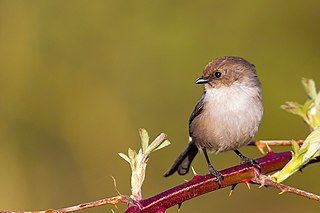
The American bushtit is the only species in the family Aegithalidae found in the New World, and the only member of the genus Psaltriparus. In North America, it is referred to simply as "bushtit".

The Gunnison grouse or Gunnison sage-grouse is a species of grouse endemic to the United States. It is similar to the closely related greater sage-grouse in appearance, but about a third smaller in size, with much thicker plumes behind the head; it also has a less elaborate courtship dance. It is restricted in range to southwestern Colorado and extreme southeastern Utah, with the largest population residing in the Gunnison Basin region in Colorado. Despite being native to a country where the avifauna is relatively well known, it was overlooked until the 1990s due to the similarities with the sage grouse, and only described as a new species in 2000—making it the first new avian species to be described from the USA since the 19th century. The description of C. minimus as a separate species is supported by a molecular study of genetic variation, showing that gene flow between the large-bodied and the small-bodied birds is absent.
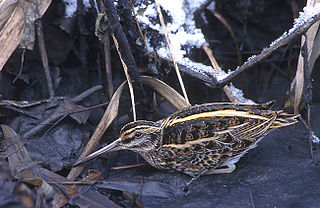
The jack snipe or jacksnipe is a small stocky wader. It is the smallest snipe, and the only member of the genus Lymnocryptes. Features such as its sternum make it quite distinct from other snipes or woodcocks.

The grey-cheeked thrush is a medium-sized thrush. This species is 15–17 cm (5.9–6.7 in) in length, and has the white-dark-white underwing pattern characteristic of Catharus thrushes. It is a member of a close-knit group of migrant species together with the veery and Bicknell's thrush; it forms a cryptic species pair with the latter. The grey-cheeked thrush is all but indistinguishable from Bicknell's thrush except by its slightly larger size and different song. The two were formerly considered conspecific. Of all the American spotted thrushes, the grey-cheeked has the most northern breeding range.
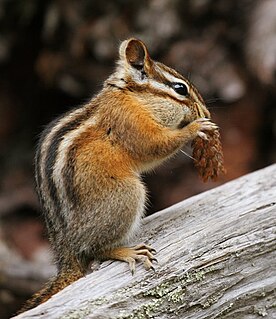
The least chipmunk is the smallest species of chipmunk and the most widespread in North America.

The water opossum, also locally known as the yapok, is a marsupial of the family Didelphidae. It is the only living member of its genus, Chironectes. This semiaquatic creature is found in and near freshwater streams and lakes from Mexico through Central and South America to Argentina and is the most aquatic living marsupial. It is also the only living marsupial in which both sexes have a pouch. The thylacine, commonly referred to as the Tasmanian tiger, also exhibited this trait, but it is now believed to be extinct.

The small blue is a Palearctic butterfly in the family Lycaenidae. Despite its common name, it is not particularly blue. The male has some bluish suffusion at the base of its upper wings but is mostly dark brown like the female. The species can live in colonies of up to several hundred and in its caterpillar stage is cannibalistic.

The long-tongued nectar bat, also known as the northern blossom bat, honey nectar bat, least blossom-bat, dagger-toothed long-nosed fruit bat, and lesser long-tongued fruit bat, is a species of megabat. M. minimus is one of the smallest species in the family Pteropodidae, with an average length of 60–85 mm. It has a reddish-brown colouring with relatively long hair compared to the other species. The hair on the abdomen is a lighter colour, and a dark brown stripe runs bilaterally down the top of the head and back.
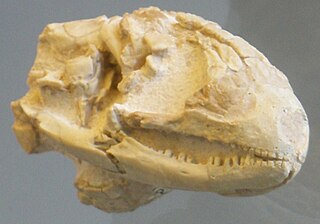
Peltosaurus is an extinct genus of anguid lizard from North America that lived from the Eocene to the Oligocene. Peltosaurus belongs to the anguid subfamily Glyptosaurinae. The type species Peltosaurus granulosus was named in 1873 by American paleontologist Edward Drinker Cope. Many additional species have been named, but most have been reassigned to different genera. For example, Peltosaurus piger, named in 1928, was reclassified as Odaxosaurus piger, and P. jepseni, named in 1942 from the Paleocene of Wyoming, but was later reclassified as Proxestops jepseni. In 1955 a new species, Peltosaurus macrodon, was named from the Eocene of California. Lizard bones from the Late Miocene of Nebraska were attributed to a new species of Peltosaurus called P. minimus in 1976, extending the fossil range of Peltosaurus and Glyptosaurinae into the Neogene. However, these bones were later referred to a genus of skinks called Eumeces, meaning that the fossil range of Peltosaurus and Glyptosaurinae does not go beyond the Paleogene.

The swamp antechinus, also known as the little Tasmanian marsupial mouse, is a species of shrew-like marsupial of the family Dasyuridae and as such is related to dunnarts, quolls and the Tasmanian devil.

The Antilocapridae are a family of artiodactyls endemic to North America. Their closest extant relatives are the giraffids with which they comprise the superfamily Giraffoidea. Only one species, the pronghorn, is living today; all other members of the family are extinct. The living pronghorn is a small ruminant mammal resembling an antelope.

The long-tongued fruit bat is a species of megabat. It is nectarivorous, feeding on nectar from primarily banana flowers. It is found in several countries in South and Southeast Asia.

Macroglossus is a genus of megabats found in Indonesia and Southeast Asia. It has two species:

The Great Nicobar serpent eagle, also known as the South Nicobar serpent eagle, is a species of bird of prey in the family Accipitridae. It is the smallest known eagle, with a weight of about 450 g and a body length of about 40 cm. It is endemic to forest on the Indian island of Great Nicobar. It is threatened by habitat loss.

Zimmer's tody-tyrant is a species of bird in the family Tyrannidae.

The East African epauletted fruit bat is a species of megabat in the family Pteropodidae. It is found in Ethiopia, Kenya, Somalia, Tanzania, and Uganda. Its natural habitats are dry savanna and rocky areas. It is threatened by habitat loss.
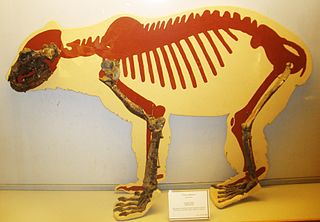
Ursus minimus is an extinct species of bear, endemic to Europe during the Pliocene and Pleistocene, living from 5.3—1.8 Mya, existing for about 3.5 million years .
Copelatus minimus is a species of diving beetle. It is part of the genus Copelatus, which is in the subfamily Copelatinae of the family Dytiscidae. It was described by Bilardo & Rocchi in 1995.

Miniargiolestes is a monotypic genus of damselflies in the family Megapodagrionidae. The single species of this genus, Miniargiolestes minimus, commonly known as a stream flatwing, is a small damselfly, metallic black to green in colour with white markings. It is endemic to south-western Australia, where it inhabits streams.
Taaningichthys paurolychnus is a species of lanternfish.
















